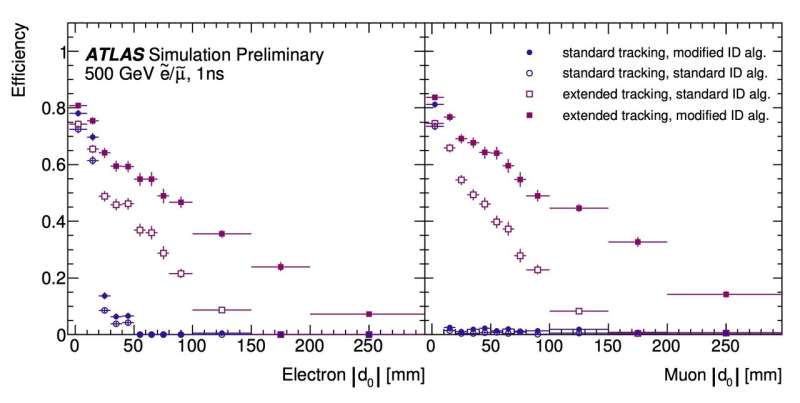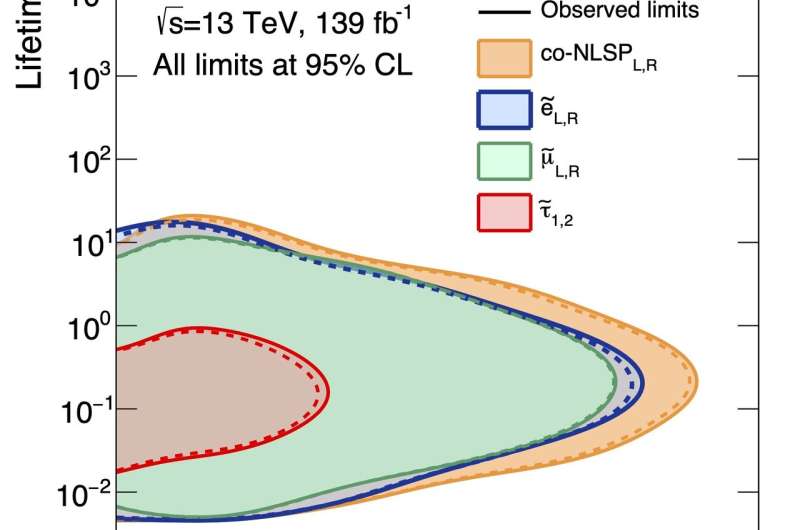ATLAS Experiment releases new search for long-lived particles

Despite its decades of predictive success, there are important phenomena left unexplained by the Standard Model of particle physics. Additional theories must exist that can fully describe the universe, even though definitive signatures of particles beyond the Standard Model have yet to turn up.
Researchers at the ATLAS experiment at CERN are broadening their extensive search program to look for more unusual signatures of unknown physics, such as long-lived particles. These new particles would have lifetimes of 0.01 to 10 ns; for comparison, the Higgs boson has a lifetime of 10–13 ns. A theory that naturally motivates long-lived particles is supersymmetry (SUSY). SUSY predicts that there are "superpartner" particles corresponding to the particles of the Standard Model with different spin properties.
A new search from the ATLAS Collaboration looks for the superpartners of the electron, muon and tau lepton, called "sleptons" ("selectron", "smuon", and "stau", respectively). The search considers scenarios where sleptons would be produced in pairs and couple weakly to their decay products and so become long-lived. In this model, each long-lived slepton would travel some distance (depending on their average lifetime) through the detector before decaying to a Standard Model lepton and a light undetectable particle. Physicists would thus observe two leptons that seem to come from different locations than where the proton–proton collision occurred.

This unique signature presented a challenge for physicists. Although many theories predict particles that could travel in the ATLAS detector for some time before decaying, typical data reconstruction and analysis is oriented towards new particles that would decay instantaneously, the way heavy Standard Model particles do. ATLAS physicists thus had to develop new methods of identifying particles in order to increase the likelihood of reconstructing these "displaced" leptons. Only displaced electrons and muons were studied in this analysis, but the results could be applied to taus as well, since taus decay promptly into an electron or a muon in around one third of cases.
Because the particles created by the decay of a long-lived particle would appear away from the collision, unusual background sources can arise: photons mis-identified as electrons, muons that are mis-measured, and poorly measured cosmic-ray muons. Cosmic-ray muons come from high-energy particles colliding with our atmosphere and can traverse the ATLAS detector. Since they do not necessarily pass through the detector near the collision point, they can appear as if originating from a long-lived particle decay. ATLAS physicists have developed techniques not only for reducing these sources' contributions but also for estimating how much each contributes to the search.
The analysis did not find any collision events with displaced leptons that passed the selection requirements, a result that is consistent with the low expected background abundance. Using these results, physicists set limits on the slepton mass and lifetime. For the slepton lifetime that this search is most sensitive to (around 0.1 nanoseconds) ATLAS was able to exclude selectrons and smuons up to a mass of around 700 GeV, and staus up to around 350 GeV. The previous best limits on these long-lived particles were around 90 GeV and came from the experiments on the Large Electron–Positron Collider (LEP), CERN's predecessor to the LHC. This new result is the first to make a statement on this model using LHC data.
More information: Search for displaced leptons in 13 TeV proton-proton collisions with the ATLAS detector (ATLAS-CONF-2020-051): cds.cern.ch/record/2740685
Provided by ATLAS Experiment





















